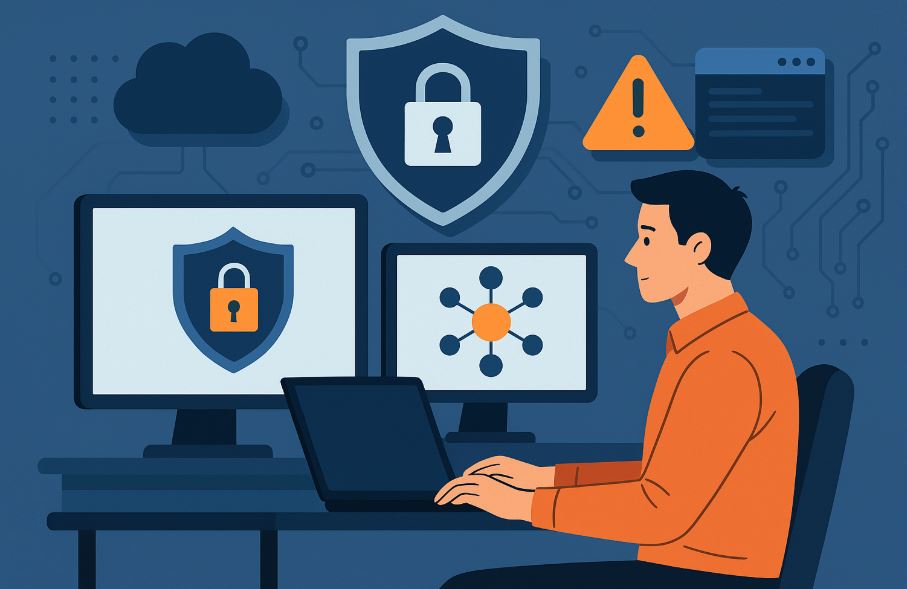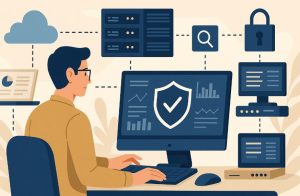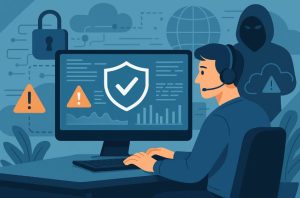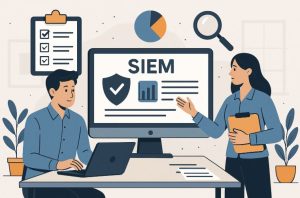
What Is SIEM?
In a digital world where cyber threats evolve faster than ever, how can organisations proactively detect and respond to risks before serious damage occurs? How can a company comply with complex security regulations while maintaining operational efficiency? This is where SIEM in cybersecurity plays a pivotal role.
Security Information and Event Management (SIEM) is a cybersecurity solution designed to provide real-time insights into an organisation’s IT infrastructure.
SIEM systems gather and analyse security event data from various sources, including applications, servers, firewalls, and cloud environments, to identify abnormal behaviour and respond to threats.
Over time, SIEM has evolved from basic log management to an intelligent, AI-powered platform that combines automation, behavioural analytics, and threat detection.
The term SIEM was coined by Gartner in 2005, combining the functionalities of Security Information Management (SIM) and Security Event Management (SEM).
While SIM dealt with storing and reporting on security logs, SEM focused on monitoring and correlating real-time events. Together, they formed a unified solution capable of handling today’s complex threat landscape.
How Does SIEM Work Across a Complex IT Environment?

At its core, a SIEM solution performs three primary tasks: data aggregation, correlation, and alert generation. SIEM software collects log and event data generated by host systems, network devices, security software, and cloud platforms. It consolidates and normalises this data for easier analysis.
Once the data is collected, SIEM tools use predefined rules, correlation engines, and increasingly, machine learning algorithms to identify patterns and detect suspicious or malicious activity.
For example, if a user logs in from two countries within minutes, or if a device attempts multiple failed logins, the SIEM system will flag this behaviour as suspicious.
The system then classifies the activity, generates alerts, and, in many cases, initiates automated responses. Advanced SIEM solutions integrate with Security Orchestration, Automation, and Response (SOAR) platforms to streamline threat mitigation.
To manage large data volumes efficiently, some SIEM systems also include preprocessing capabilities that filter data before it reaches the central analysis engine, reducing unnecessary load and improving speed.
What Are the Key Features of a Modern SIEM Platform?
SIEM systems are not monolithic. They offer a variety of capabilities depending on the vendor and the organisation’s needs. However, the following features are typically included:
- Data Aggregation: Collects data from on-premises and cloud-based infrastructure, including endpoints, applications, firewalls, and servers.
- Event Correlation: Uses analytics to identify complex attack patterns by linking related events across systems.
- Incident Detection and Alerting: Automatically identifies and ranks incidents by severity and potential impact.
- User and Entity Behaviour Analytics (UEBA): Detects insider threats by analysing behaviour that deviates from established baselines.
- Compliance Reporting: Generates reports for regulations like GDPR, HIPAA, PCI-DSS, and SOX.
- Forensics and Investigation: Reconstructs the timeline of an attack to aid in incident response and prevention.
Below is a summary of typical SIEM features and what they achieve:
| Feature | Function |
| Log Management | Aggregates logs from all security-relevant sources |
| Event Correlation | Links related security events for threat detection |
| Real-time Monitoring | Enables immediate visibility and alerting |
| Automated Incident Response | Initiates mitigation workflows using predefined actions |
| Compliance Auditing | Automates report generation to meet regulatory requirements |
| Dashboards and Visualisation | Displays threat data for easier analysis and management |
How Does SIEM Improve Threat Detection and Response?

Threat detection is no longer a luxury; it’s a necessity. SIEM platforms allow organisations to detect sophisticated cyber threats, including zero-day attacks, insider threats, and advanced persistent threats (APTs), that traditional defences might miss.
These platforms excel at creating a comprehensive picture by bringing together fragmented pieces of data from across the digital estate. When integrated with threat intelligence feeds, SIEM systems can match internal activity against known attack signatures, speeding up detection and response.
Response capabilities are significantly enhanced through automation. Many SIEM systems allow for predefined rules that can automatically trigger containment procedures such as blocking IP addresses, isolating affected endpoints, or suspending compromised user accounts.
This capability drastically reduces Mean Time to Detect (MTTD) and Mean Time to Respond (MTTR), two critical metrics in cyber defence.
What Benefits Does SIEM Offer to Organisations?
Implementing a SIEM solution offers substantial benefits for organisations aiming to strengthen their cybersecurity posture:
Real-time Threat Recognition
By constantly monitoring network traffic and user activity, SIEM enables immediate identification of anomalies. This allows security teams to act before an attack escalates.
Automated Workflows
SIEM systems powered by AI and machine learning can automate threat detection, incident classification, and even initiate responses without human intervention.
Centralised Security Operations
All security events are viewed and managed through a single pane of glass, promoting efficiency and reducing the risk of oversight.
Forensic Investigation
Detailed logs enable teams to recreate security events, determine the attack vectors, and identify weaknesses in the infrastructure.
Compliance Efficiency
Rather than manually gathering evidence for audits, teams can produce on-demand reports that demonstrate ongoing compliance with security frameworks.
Scalability
Modern SIEM platforms are designed to handle increasing amounts of data as an organisation grows, especially cloud-native solutions, which scale automatically.
Why Is SIEM Important for Compliance and Audit Management?

Many industries are governed by strict regulatory frameworks. Failure to comply with these can result in substantial financial penalties and reputational damage. SIEM simplifies this process by automating the collection, storage, and analysis of security-related data.
It can generate audit-ready reports for common standards such as:
- GDPR (General Data Protection Regulation)
- HIPAA (Health Insurance Portability and Accountability Act)
- PCI-DSS (Payment Card Industry Data Security Standard)
- SOX (Sarbanes-Oxley Act)
Instead of manually aggregating logs across systems, security teams can rely on SIEM to deliver accurate and timely compliance documentation.
What Are the Common Challenges in SIEM Deployment?
While SIEM provides immense value, its implementation can present challenges:
- Complex Deployment and Integration: Setting up a SIEM system requires careful planning, especially when integrating with a wide range of existing tools and systems.
- High Costs: The financial investment for licensing, infrastructure, and skilled personnel can be significant, particularly for on-premise solutions.
- Alert Overload: Without proper tuning, SIEM systems may generate thousands of alerts daily, overwhelming analysts and leading to alert fatigue.
- Skill Requirements: Running a SIEM effectively demands in-depth knowledge of cyber security, data analytics, and incident management, skills that are often in short supply.
- Misconfiguration Risks: Incorrect configurations can lead to missed threats or excessive false positives, undermining the effectiveness of the platform.
What Are Best Practices for Implementing a SIEM System?
To maximise the value of SIEM, organisations should follow these implementation best practices:
- Set Clear Objectives: Define what you want your SIEM to achieve, whether it’s improving threat detection, simplifying compliance, or consolidating monitoring.
- Map Compliance Requirements: Identify applicable regulations and ensure the system is configured to monitor and report against them.
- Catalogue Digital Assets: Document all systems, applications, and devices across the network to determine what data needs to be collected.
- Define Correlation Rules: Use predefined and custom rules to link suspicious activities and reduce noise from non-critical alerts.
- Test Incident Response Plans: Simulate real incidents to ensure your team knows how to react when alerts are triggered.
- Assign Responsibility: Designate a SIEM administrator or team responsible for oversight, maintenance, and continuous improvement.
- Leverage Automation: Use machine learning and SOAR integrations to automate routine tasks and respond faster to threats.
How Should Organisations Choose a SIEM Tool?

Selecting the right SIEM platform depends on several organisational factors, including infrastructure, compliance needs, and budget. Here’s a comparison of key evaluation points:
| Evaluation Criteria | Considerations |
| Integration | Can the tool connect with existing infrastructure and controls? |
| Cost | What are the total ownership and maintenance costs? |
| Deployment Model | Does the tool support cloud, on-premise, or hybrid environments? |
| Threat Intelligence Support | Can it integrate with external and proprietary threat feeds? |
| Compliance Reporting | Does it offer templates or customisable compliance reports? |
| Vendor Support | Is technical support and training accessible? |
Top vendors in this space include IBM QRadar, Splunk, LogRhythm, ManageEngine Log360, and Exabeam, each offering different strengths for different types of organisations.
What Is the Future of SIEM in a Changing Cyber Security Landscape?
As data environments become more complex, the future of SIEM is being shaped by AI, machine learning, cloud computing, and IoT. Next-generation SIEM platforms are expected to deliver:
- Smarter automation capable of learning from every event
- Broader integration with endpoint detection and response (EDR), SOAR, and extended detection and response (XDR) platforms
- Cloud-native capabilities that support dynamic environments and scale effortlessly
- Improved user interfaces for faster investigation and threat hunting
Ultimately, SIEM is transforming into a smarter, more autonomous component of an organisation’s overall security architecture.
FAQs About SIEM in Cyber Security
What types of threats can SIEM detect?
SIEM detects both internal and external threats, including ransomware, phishing, DDoS attacks, insider threats, and data exfiltration.
Is SIEM only for large enterprises?
No, SMEs can also benefit from SIEM, especially through managed services or cloud-native tools that reduce upfront costs.
Can SIEM tools help in post-attack investigations?
Yes, SIEM stores detailed logs that help forensic teams reconstruct attacks and determine the cause.
How often should SIEM configurations be reviewed?
Regular reviews, at least monthly, are essential to optimise rules, reduce false positives, and align with emerging threats.
Are SIEM solutions effective in hybrid environments?
Modern SIEM systems are designed to operate in hybrid environments, offering visibility across both cloud and on-premise assets.
What is the role of AI in SIEM?
AI enhances SIEM by learning from patterns and reducing manual effort in detection and response.
What’s the difference between SIEM and SOAR?
SIEM focuses on detecting and analysing security events, while SOAR automates the response and orchestrates security workflows.